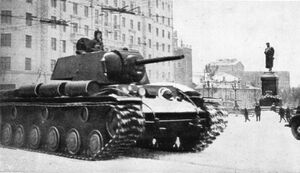Bienor: Difference between revisions
No edit summary |
No edit summary |
||
| Line 30: | Line 30: | ||
The '''Bienor''' was a heavy tank produced by the [[Republic of Syara]]. It saw service with the [[Inner Sphere]] during the [[Siduri War]]. | The '''Bienor''' was a heavy tank produced by the [[Republic of Syara]]. It saw service with the [[Inner Sphere]] during the [[Siduri War]]. | ||
During the [[Invasion of Ruvelka (Siduri War)|invasion]] of [[Ruvelka]] the [[Army of the Syaran Republic had encountered the [[Kristóf Barta Heavy Tank]], which was larger and more heavily armored than most Syaran armored vehicles. With the [[Rhaecus]] a tactically infeasible design, there was a push for a more conventional but powerful heavy tank that could defeat any [[Common Axis]] armored vehicle. Experience on the [[Quenminese Front]] shaped Syaran expectations and resulting in the Beinor's introduction in December 1935. The result was a heavily armored and armed tank, but an unreliable and mechanically complex vehicle that earned mixed reputations with its crew. Despite its shortcomings the tank was pressed into service and saw action in all major theaters, suffering heavy losses in the process. Following the withdrawal of the [[Shirvani Dominion]] in mid-1937, the remaining Bienor's were withdrawn back to occupied Ruvelka, where they ast saw action during the final Common Axis [[Liberation of Ruvelka|offensives]] of the war. | During the [[Invasion of Ruvelka (Siduri War)|invasion]] of [[Ruvelka]] the [[Army of the Syaran Republic]] had encountered the [[Kristóf Barta Heavy Tank]], which was larger and more heavily armored than most Syaran armored vehicles. With the [[Rhaecus]] a tactically infeasible design, there was a push for a more conventional but powerful heavy tank that could defeat any [[Common Axis]] armored vehicle. Experience on the [[Quenminese Front]] shaped Syaran expectations and resulting in the Beinor's introduction in December 1935. The result was a heavily armored and armed tank, but an unreliable and mechanically complex vehicle that earned mixed reputations with its crew. Despite its shortcomings the tank was pressed into service and saw action in all major theaters, suffering heavy losses in the process. Following the withdrawal of the [[Shirvani Dominion]] in mid-1937, the remaining Bienor's were withdrawn back to occupied Ruvelka, where they ast saw action during the final Common Axis [[Liberation of Ruvelka|offensives]] of the war. | ||
==Development== | ==Development== | ||
Latest revision as of 14:45, 26 January 2022
| Bienor | |
|---|---|
 | |
| Type | Heavy tank |
| Place of origin | Republic of Syara |
| Service history | |
| Used by | Inner Sphere |
| Wars | Siduri War |
| Production history | |
| Produced | 1935-1938 |
| No. built | 2,644 |
| Specifications | |
| Weight | 45 tons |
| Length | 6.75 m (22 ft 2 in) |
| Width | 3.32 m (10 ft 11 in) |
| Height | 2.71 m (8 ft 11 in) |
| Crew | 5 |
| Armor | 90 mm |
Main armament | 76 mm |
Secondary armament | 3 x 7.5mm machine guns |
| Engine | V-12 diesel engine 13 hp/ton |
| Suspension | Torsion bar |
Operational range | 225 km |
| Speed | 35 km/h (22 mph) |
The Bienor was a heavy tank produced by the Republic of Syara. It saw service with the Inner Sphere during the Siduri War.
During the invasion of Ruvelka the Army of the Syaran Republic had encountered the Kristóf Barta Heavy Tank, which was larger and more heavily armored than most Syaran armored vehicles. With the Rhaecus a tactically infeasible design, there was a push for a more conventional but powerful heavy tank that could defeat any Common Axis armored vehicle. Experience on the Quenminese Front shaped Syaran expectations and resulting in the Beinor's introduction in December 1935. The result was a heavily armored and armed tank, but an unreliable and mechanically complex vehicle that earned mixed reputations with its crew. Despite its shortcomings the tank was pressed into service and saw action in all major theaters, suffering heavy losses in the process. Following the withdrawal of the Shirvani Dominion in mid-1937, the remaining Bienor's were withdrawn back to occupied Ruvelka, where they ast saw action during the final Common Axis offensives of the war.